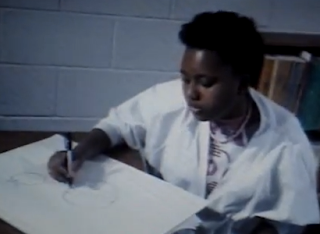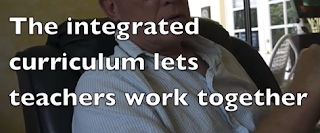End-of Year Exhibitions
Exhibitions
Most teachers ask students to complete a test at the end of a course. The Final Exam. This process works well for students who like writing. Is there another way to find out what a student knows?
What role could exhibitions play in our learning? How can students show what they understand?
There's a movie called Stand and Deliver. It stars Edward Almos. He plays a teacher who asks his students to stand and deliver what they know.
Please read the reading from the Big Picture and think about the questions below.
The reading from Big Picture:
P. 165-167
Schools that use exhibitions as a method of assessment need to make sure that the students, staff, and parents understand the requirements and purpose of exhibitions. They also need to maximize exhibitions’ incredible value in building relationships in the school.
First, exhibitions are an amazing opportunity for parent involvement. Parents get to see their kids in action and get to actually hear them talk about what they’ve done and what they’ve learned, rather than just guessing about it based on a report card grade or assuming it’s happened because the kids are walking across the stage at graduation. An exhibition is a chance for every parent to see his or her child perform, a chance to be proud. It is also a chance for them to question their child about school and not have him say, “It’s fine,” and then walk away and go to his room. Our Met parents say things like, “I loved seeing my son’s autobiography—I was so proud to see how he’d written more than 100 pages analyzing his life and his education,” and “I was amazed to watch my daughter take her love for marine biology and develop her own curriculum so she could teach it to the other kids at her school.”
Second, exhibitions are a great opportunity for teachers to really work together as a team. By sitting in on exhibitions given by their colleagues’ students, individual teachers become part of a community that is invested in helping to teach each child. This opportunity to witness another teacher’s struggles or successes with individual students also helps all teachers become better equipped to provide the kind of collegial support that is vital to a healthy school.
Third, exhibitions are an opportunity to include the outside community in education by inviting others to come in and watch: local leaders, college students, professors, mentors, school board members, everyone. Every time I watch exhibitions at The Met, I’m reminded that I’m seeing our most sophisticated student-adult conversations. The interaction between the student and the audience creates a whole new level of communication where the student is at the center but is also receiving input from everyone about his or her learning.
Fourth, exhibitions promote rather than inhibit growth. This means that when an exhibition isn’t that great, or when the kid really isn’t prepared or hasn’t shown progress on his work, it is still an opportunity for others to see and applaud growth in other areas. In situations where I don’t feel students did a great job on their exhibitions, I have to remember to ask myself, “Not great compared to what?” Even after a “bad” exhibition, I have heard parents say things like, “My son has never talked like that in front of a group before—I can’t believe he did that!” One of our students started her exhibition by warning the audience that she had a stutter. As it turned out, she didn’t stutter once during the entire presentation—but if she had, she would have been showing us her courage, her determination to keep going and to make herself under- stood. With every exhibition, there is always an upside, always some- thing learned. When you fail a test, you just fail, end of story. There is no end to the story with exhibitions. The learning keeps on happening.
Fifth, exhibitions completely eliminate cheating. In a 1998 survey by Who’s Who Among American High School Students, 80 percent of college- bound high schoolers admitted they’d cheated at least once. As a Met student once said, “You can cheat your way through other high schools and you can cheat your way through elementary and middle school, but here you cannot cheat at all. It’s impossible. When you have to stand in front of everyone and do your exhibition, you’ve got to have something.”
Sixth, exhibitions encourage students to go deeper with their learning by requiring them to create and present a portfolio of their work. Where studying for a test may involve students looking at class notes and rereading textbooks, preparing a portfolio requires students to look at and define the many layers of their learning. This can mean sharing successive drafts of a paper, showing photos of a project in various phases of construction, and all sorts of other things. Deep learning is so important, and such a thrill to do and to watch.
Tests can do a lot of damage to a person who really wants to take learning further, branch out, learn more. I saw it myself back in college. My roommate and I were taking the same English course and had to read Joseph Conrad’s Heart of Darkness. I read the book eight times (and ended up hating it) because it was going to be on the test and I knew I had to “know” it. My roommate loved the book and went on to read every book Conrad had ever written. I got an A on the test. My roommate got a D.
Clearly, deeper learning was not valued in that course. I got the “good” grade, but I knew my roommate had learned more than I had and that he had gotten more out of the book. And I envied the way he pursued his passion.
Finally, exhibitions allow, and require, students to set high standards for themselves. When they don’t do well at an exhibition, they know it—immediately. They don’t have to wait for a test score to come back to tell them they need to work harder. And if they have a personalized learn- ing plan (like all Met students do), they help determine what constitutes “doing well.” Exhibitions force students to become accountable for and take control of their own learning. Isn’t that what we’re striving for?
For Discussion
1. What advantages would there be to you if you could hear your students give a verbal presentation instead of a written answer?
2. Do you remember a particular grade you received on a school assignment? Why do you remember it? What significance did it hold?
3. Why don’t teachers traditionally give students other kinds of feedback besides grades?
What other kinds of feedback would you have liked to have received as a student?










































